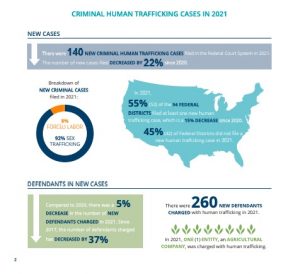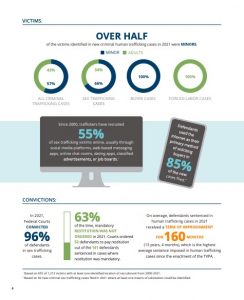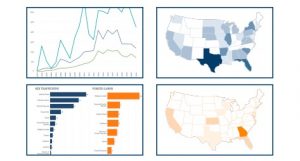
2021 Federal Human Trafficking Report
Executive Summary
Human trafficking is the crime of using force, fraud, or coercion to compel an individual to work or to engage in a commercial sex act. Prosecuting human traffickers is part of a holistic approach to combating this pervasive form of exploitation. The Human Trafficking Institute’s (HTI) annual Federal Human Trafficking Report (“the Report”) provides an exhaustive review of human trafficking cases in the United States Federal Courts System. To date, this is the only review of its kind. The Report presents data from both criminal forced labor and sex trafficking prosecutions.



Interactive Data Website
The Federal Human Trafficking Report was first published in 2017 as the only exhaustive review of every criminal human trafficking case filed in the United States Federal Courts. Since then, the Report has captured data from thousands of human trafficking cases filed since the Trafficking Victims Protection Act (TVPA) was enacted in 2000. The data published in the Report each year is only a small representation of the amount of data collected from those cases and stored within the HTI database. This year, the Report seeks to make some of those additional data points available to readers through an interactive section of our website, with the ability to download PDFs of the data visuals. These interactive features will allow readers more hands-on access to the data held within the Report database so as to explore beyond the information provided in the published Report. Readers can now manipulate filters to review more information on: • Prosecution of Human Trafficking Cases • Victims in Cases by District • Recruiters in Human Trafficking Cases • Industries Identified in Forced Labor Cases We hope this new interactive feature will help provide objective data that can be used to inform prosecutors, investigators, policymakers, service providers, and practitioners.

Click here to view the interactive data
Introduction
Human trafficking is a complex and nuanced crime. Traffickers use a multitude of methods and schemes to recruit, coerce, and exploit victims in both forced labor and commercial sex trafficking. Each human trafficking case filed in the Federal Court System is different, presenting its own unique set of facts, methods, and schemes. Raw data regarding these specific facts, when examined independently, provides limited information as to how traffickers operate, and how cases are investigated or prosecuted. These individual data points, when examined narrowly and independently, appear futile. But much like an impressionist painting, when these specific data points are extracted from multiple cases over time, organized, and then examined on a wider more comprehensive scale, they paint a much clearer image of human trafficking in the United States. The Federal Human Trafficking Report (“the Report”) captures raw data identified in human trafficking cases filed in the Federal Court System, disaggregates, and verifies the data, and organizes it in such a way as to transform individual data points into information and insight. The data provided in the Report is intended to serve as a resource and a tool for prosecutors, investigators, and practitioners in their efforts to combat human trafficking. The Report is neither an indicator of the prevalence of human trafficking in the United States nor a reflection of the investigations and prosecutions that take place at the state level, outside the Federal Court System.
“The Report is neither an indicator of the prevalence of human trafficking in the United States nor a reflection of the investigations and prosecutions that take place at the state level, outside the Federal Court System.”
SECTIONS
The Report is arranged into three sections. Section 1, Criminal Human Trafficking Case Profiles, breaks down the profile of new criminal human trafficking cases filed in the Federal Court System in 2021. It examines the types of cases filed, provides information on the defendants charged, and discusses various data points relating to the victims identified in those cases. Section 2, Human Trafficking Prosecutions, shifts focus from how traffickers operate to how the U.S. investigates and prosecutes defendants in human trafficking cases. This section provides data on case referrals, investigations, charges, convictions, sentences, and appeals. Finally, Section 3, Uganda & Belize, introduces the data-driven approaches HTI is implementing in our Partner Countries as we expand the use of data collection and analysis to reach targeted goals.
FOCUS ON NEW CASES
The FHTR database boasts twenty-one years of data from the thousands of human trafficking cases filed since the TVPA was enacted in 2000. Because of the breadth of data available, the 2021 Report shifts focus from providing information on pending active cases, and instead focuses primarily on new cases filed, year-over-year. This shift is intended to eliminate data from older cases that are still pending as active cases that would skew new trends, such as common apps or internet websites used in trafficking schemes. This year, the Report focuses on providing data from the new cases filed each year so that a more specific comparison of trends can be made year-over-year using the most relevant data points.
NEW DATA FIELDS
In 2021, the Report captured numerous new data points from human trafficking cases filed in the Federal Court System. Some of the new data points featured throughout the Report include information regarding the identification of the involvement of a task force in investigations, locations where victims are commonly recruited, how victims are transported, pre-existing relationships between traffickers and victims prior to recruitment, and methods through which human trafficking cases are referred to law enforcement. A full list of the new data points included in the 2021 Report can be found in the Methodology on page 117.
Read full report here.
